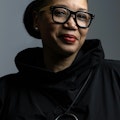None of us can anticipate the future with perfect accuracy (however, if you’re the exception that proves this rule, please spill your secrets!) But thinking deeply and strategically about what comes next—and acting on those insights—is key to effective design and effective decision-making.
Analyzing information and trends that point to what’s ahead, and solving for challenges on the horizon, is the core purpose of Future Today Institute (FTI), and of IIDA member Mark Bryan. I recently had a conversation with Mark, an FTI senior foresight manager focused on the built environment and IIDA’s Futurist in Residence, about the shifting landscape of design, the careful methodology behind foresight, and how the design industry can develop skills that will help us shape the future we want to see.*
Cheryl Durst: What brought you to this work?
Mark Bryan: My background is in commercial design. I practiced in the field for about 20 years, working across sectors like workplace, multi-family, healthcare, higher education and hospitality. About six or seven years ago, I noticed my clients were getting stuck—they often struggled to understand and apply trends. So, I started doing a lot of research, writing white papers, hosting trend forecasting events, and organizing roundtables. But I was bringing more data to a data overload problem, which added to the confusion.
I then transitioned to looking for new evidence-based practices to help clients pre-experience potential future states of their projects, whether it be a classroom or a workplace. This shift began after I attended an industry conference, met some futurists, and realized the parallels between design and strategic foresight: both fields use data to envision and plan for what doesn’t exist yet.
Now, at FTI, I use strategic foresight to anticipate disruptive changes based on solid evidence, enabling clients to shape their future rather than merely reacting to it.
CD: What is strategic foresight, exactly? How does it differ from trend forecasting?
MB: That’s a very important distinction. There are people who forecast trends and practice speculative design, which is very important work. However, forecasting is a more linear approach to determining one point of a future that usually is more focused on the market. Strategic foresight involves a structured methodology to examine broader futures outside and inside the market. It’s how we get a complete picture of the futures that are possible. We start by identifying signals of change from present data, which helps us understand the uncertainties of the future and contemplate various evidence-based scenarios for the next 5-20 years.
We research forces that drive global change, from technology to media, climate to government, geopolitics to wealth distribution. This enables us to rehearse potential futures, equipping our clients to strive towards certain outcomes and avoid others. Many claim the title of “futurist,” but FTI’s approach is grounded in formal, rigorous research. Our methodology is as crucial as credentials like the NCIDQ certification are to the design industry.
Strategic foresight can be applied to the entire design process, from schematic design through construction administration. The aim is to foster innovation, provoke action, and prevent a repetitive sameness that can show up in the industry.
CD: Why do you think that sameness crops up in design?
MB: My guess is that it’s due to being deeply influenced by immediate and prevalent information, a concept known as the “availability heuristic.” Everybody gets caught up in the hype cycle of what is front and center—current events, popular media, conversations with friends—rather than long-term shifts.
Strategic foresight urges consideration of less immediate, but critically important, issues. The pandemic is a prime example of something we should have been better prepared for, as well as things like extreme weather conditions or evolving educational needs. The key to effective foresight in design is to engage clients early, providing them with external insights and data in a form that they can easily understand and relate to. Instead of overwhelming clients with dense reports, presenting information in a more digestible and engaging format can help them visualize and plan for future possibilities.
CD: How do you respond to skepticism about strategic foresight as mere smoke and mirrors?
MB: Here’s the deal: strategic foresight is not about predicting the future or getting it exactly right. Strategic foresight is being prepared for eventualities. The future is a continuum of possibilities, with near-term futures being more defined. The further out you get, the more possibilities multiply as different factors intersect. Strategic foresight frameworks explore these intersections and identify commonalities that might appear in multiple plausible futures.
CD: What are the most exciting design developments you see ahead?
MB: AI is top of mind for everybody in our industry. There’s tremendous opportunity, not just technologically but also in reshaping client engagement and experience. Material innovations like metamaterials and advanced manufacturing are also fascinating. But AI is particularly intriguing because it allows us to enhance and diversify design services and augment physical experiences with digital elements. We’re seeing innovations like face computers and AI pins that interact and engage with us, which could revolutionize how spaces are personalized. New technology also allows us to add sensory experiences to designs, making them more immersive. You know, they’re digitizing senses now. There are actually ways to capture something you tasted and share it with somebody across the world.
CD: How can designers prepare for the unexpected?
MB: Being okay with uncertainty is hard. Most people, especially leaders, are not comfortable with accounting for uncertainties or using them to their advantage. Often, decision-makers rely on trend reports, which provide a snapshot of potential futures but don’t necessarily equip them to handle unforeseen changes effectively. The key is to deeply consider the unknowns and variables that might shift. Being prepared for the future means imagining yourself and your projects within it. It means asking, “What will our business, our environment, our needs look like in five or 10 years?” and planning accordingly.
CD: Do you ever find yourself caught off guard?
MB: You know what’s funny? When I’m caught off guard by something, I get very excited—it means there’s a development that I hadn’t considered, and I need to push myself to think more broadly. There is no way to predict everything, but I think that we can be prepared for almost anything.
*The conversation has been lightly edited for length and clarity.
About the Author

Cheryl Durst
An exceptional communicator, innovator, and visionary leader, Cheryl Durst has spurred progress, driven change, and encouraged the expansion of the Interior Design industry. As the Executive Vice President and Chief Executive Officer of the International Interior Design Association (IIDA), Cheryl is committed to achieving broad recognition for the value of design and its significant role in society through both functionality and engagement in every day work spaces and the built environment. Demonstrated by her active involvement in connecting industry professionals, including designers, manufacturers, clients, end users, and employers, she has worked to promote an understanding of how design impacts human behavior and affects all aspects of shared spaces.
In 1997, Cheryl joined IIDA as the Senior Director of Education and Professional Development. Promoted to Executive Vice President and Chief Executive Officer in 1998, she began the task of rebuilding and redefining the organization, which was teetering on the brink of bankruptcy and closure due to organizational mismanagement. Despite this significant challenge, Cheryl implemented an aggressive fiscal redevelopment and turnaround strategy. Through her efforts, she revived the association and repositioned it as a profitable enterprise, integral to the interior design community and dedicated to furthering the profession of interior design.
Today, with 15,000 members across 58 countries, Cheryl oversees the strategic direction of IIDA, curates and publishes Perspective, the association’s thought-leadership journal, manages a team of 25 professional staff members, leads the 10-member International Board of Directors, and directs all outreach and programmatic efforts, including more than a dozen global design competitions, which recognize worldwide excellence in interior design.

